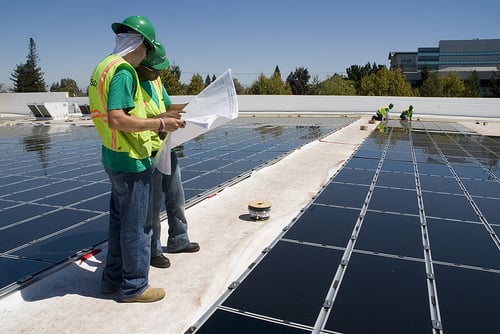
The California Public Utilities Commission yesterday (16th November) voted to approve a ‘proposed decision’ changing the state’s virtual net energy metering (VNEM) scheme for multiple-meter properties and small businesses like schools, farms, apartment blocks and shopping centres.
The now-approved VNEM proposal reduces the compensation paid to building owners and tenants for excess power produced by a rooftop solar system, by requiring them to buy their own electricity back from the grid at retail prices set by utility companies.
Try Premium for just $1
- Full premium access for the first month at only $1
- Converts to an annual rate after 30 days unless cancelled
- Cancel anytime during the trial period
Premium Benefits
- Expert industry analysis and interviews
- Digital access to PV Tech Power journal
- Exclusive event discounts
Or get the full Premium subscription right away
Or continue reading this article for free
Ahead of the vote, the CPUC proposal was changed to allow net metering for multi-meter residential properties like apartment blocks. However, communal areas like EV charging stations, hallways and gyms are exempt, which raises questions over the financial incentives for building owners to install solar.
As with the net energy metering (NEM) 3.0 vote in December 2022, which reduced the compensation for excess solar power for single-meter residential properties, the CPUC’s decision has been met with criticism by members of the Californian solar industry.
CALSSA – the California Solar and Storage Association – said that the changes “eliminate a major incentive to go solar” for Californians.
Executive director Bernadette Del Chiaro said: ““It is astonishing how intent the CPUC is on continuing to block the growth of solar at the expense of consumers and our state clean energy goals for the benefit of big utilities like PG&E.
“This decision is yet another loss for consumers and another step backwards for California’s clean energy goals and fight against climate change—the only winners here are big utilities and their shareholders.”
The vote itself was delayed twice from its initial October 2nd date. According to Chris Hopper, the CEO and co-founder of San Franciso-based solar software company Aurora Solar, the delay “shows that the community has real, legitimate questions about why this is necessary, who this benefits, and why CPUC is doing it now, so close to NEM3.”
Indeed, prior to the second proposed date for the vote, on the 2nd November, a coalition of education and health organisations publicly condemned the VNEM proposal. CEO of the Petaluma Health Center, Pedro Toledo said at the time that “when we are forced to buy back the energy we create from the utilities at an inflated amount, we all lose, especially the historically underserved communities we serve.”
Hopper continued: “There’s no arguing that rent and cost of living in California are high, and solar is a real way to defer those expenses. This further eats away at that, and unfortunately, it impacts vulnerable communities who are easily hurt by high costs: renters, farmers, and small businesses.
“Overall, the change in pricing structures is going to have a much larger impact on low-income communities that were interested in solar adoption but no longer will see the returns needed to make it a viable option; they may not have the financial flexibility to also invest in storage solutions.”
At the time of the NEM 3.0 vote, the CPUC said that the change was designed to incentivise residential energy storage systems and support the Californian grid by rewarding consumers for using their own stored energy at peak times. Similar arguments are at play regarding VNEM.
It has also been said that incentive payments to rooftop solar owners ultimately increase utility bills for customers who don’t have solar, many of whom likely cannot afford to, though this is disputed by many solar advocates.
In a relatively unsurprising contrast to the solar industry reaction, NEM 3.0 was welcomed by California’s residential energy storage companies, as covered in detail by our sister publication Energy-storage.news. Industry representatives said that the change would make renewable energy more ‘dispatchable’ and increase energy resilience.
But the short-term data may tell a different story. According to data from Aurora Solar there was an over 30% decrease in solar project designs across California in the six months following NEM 3.0’s implementation in April. This is potentially a concerning statistic for a state which has traditionally set trends in solar adoption for the US, and by extension for much of the world.
How VNEM changes will unfold compared to the initial NEM decision remains to be seen.
Looking ahead, Chris Hopper of Aurora Solar concluded: “Just like NEM3 didn’t destroy the California solar industry, neither will this.. Solar is inevitable. It’s efficient, it’s clean, it’s an unlimited resource. So, this might slow down solar’s growth in the near term, but in the long term, solar and other renewables for all is clearly where we’re headed.”






